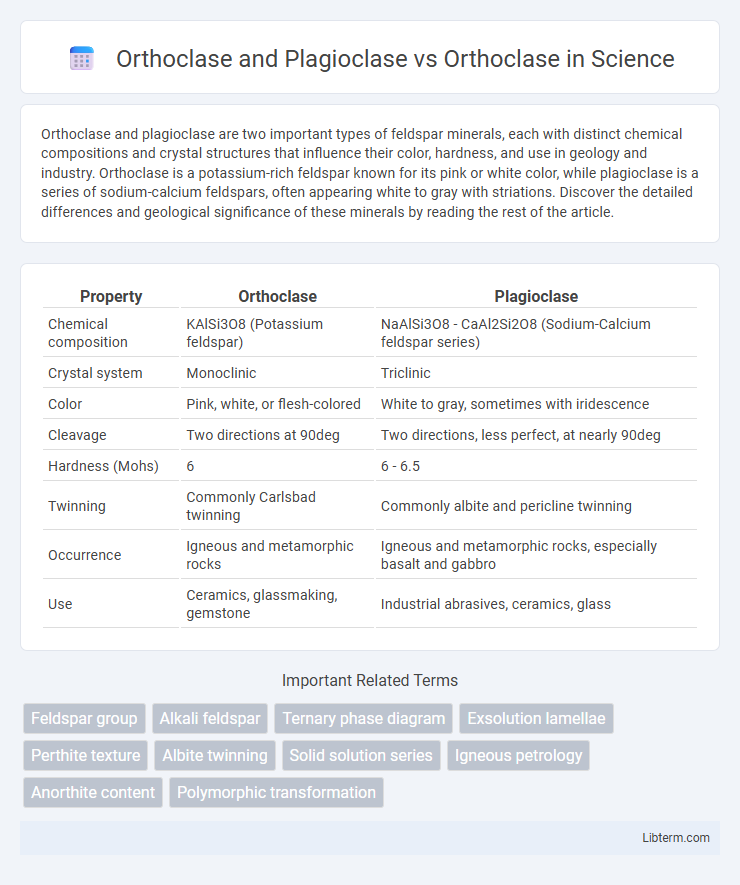Orthoclase and plagioclase are two important types of feldspar minerals, each with distinct chemical compositions and crystal structures that influence their color, hardness, and use in geology and industry. Orthoclase is a potassium-rich feldspar known for its pink or white color, while plagioclase is a series of sodium-calcium feldspars, often appearing white to gray with striations. Discover the detailed differences and geological significance of these minerals by reading the rest of the article.
Table of Comparison
| Property | Orthoclase | Plagioclase |
|---|---|---|
| Chemical composition | KAlSi3O8 (Potassium feldspar) | NaAlSi3O8 - CaAl2Si2O8 (Sodium-Calcium feldspar series) |
| Crystal system | Monoclinic | Triclinic |
| Color | Pink, white, or flesh-colored | White to gray, sometimes with iridescence |
| Cleavage | Two directions at 90deg | Two directions, less perfect, at nearly 90deg |
| Hardness (Mohs) | 6 | 6 - 6.5 |
| Twinning | Commonly Carlsbad twinning | Commonly albite and pericline twinning |
| Occurrence | Igneous and metamorphic rocks | Igneous and metamorphic rocks, especially basalt and gabbro |
| Use | Ceramics, glassmaking, gemstone | Industrial abrasives, ceramics, glass |
Introduction to Orthoclase and Plagioclase
Orthoclase and plagioclase are two major types of feldspar minerals essential in igneous and metamorphic rocks, distinguished by their chemical compositions and crystallographic properties. Orthoclase, a potassium-rich feldspar (KAlSi3O8), typically forms in granitic rocks and exhibits a pink or flesh-colored appearance, while plagioclase represents a solid solution series ranging from sodium-rich albite (NaAlSi3O8) to calcium-rich anorthite (CaAl2Si2O8). Understanding the differences between orthoclase and plagioclase is crucial for mineralogists and geologists in rock classification, petrogenesis, and geochronology studies.
Chemical Composition: Orthoclase vs Plagioclase
Orthoclase primarily consists of potassium aluminum silicate (KAlSi3O8), distinguishing it chemically from plagioclase, which is a series of tectosilicate minerals composed of varying amounts of sodium and calcium aluminosilicates (NaAlSi3O8 to CaAl2Si2O8). The chemical composition of plagioclase ranges from albite (sodium-rich) to anorthite (calcium-rich), making it a solid solution series, whereas orthoclase is potassium-dominant without significant substitution. This distinct chemical variation affects their physical properties and stability in different geological environments.
Crystal Structure Differences
Orthoclase and plagioclase feldspars differ fundamentally in their crystal structures; orthoclase exhibits a monoclinic system with a well-ordered potassium-rich framework, while plagioclase spans a solid solution series with varying sodium and calcium content in its triclinic structure. Orthoclase crystals often form well-defined tabular shapes, contrasting with the more complex twinning and compositional zoning common in plagioclase crystals. These structural variations influence properties such as cleavage, optical behavior, and stability in igneous and metamorphic environments.
Physical Properties Comparison
Orthoclase and plagioclase both belong to the feldspar group but differ significantly in physical properties; orthoclase typically exhibits a hardness of 6 on the Mohs scale, with a white to pink color and two distinct cleavage directions at nearly 90 degrees. Plagioclase feldspar ranges in hardness from 6 to 6.5, displaying a broader color range from white to gray or bluish, and shows characteristic striations on cleavage surfaces not present in orthoclase. These distinctions in hardness, cleavage, and color aid in identifying feldspar minerals in geological samples.
Occurrence and Abundance in Nature
Plagioclase feldspar constitutes approximately 39% of the Earth's continental crust, making it the most abundant feldspar group, whereas orthoclase feldspar accounts for about 12%. Plagioclase commonly occurs in igneous rocks such as basalt and gabbro, while orthoclase is prevalent in granite and pegmatites. The widespread distribution of plagioclase reflects its dominance in mafic to intermediate rock types, contrasting with the more felsic environments favoring orthoclase formation.
Color and Appearance Variations
Orthoclase commonly exhibits a range of colors from white and cream to pink and salmon hues, often appearing translucent with a vitreous luster. Plagioclase shows a more diverse color palette including white, gray, and bluish tones, featuring distinctive striations on crystal surfaces that differentiate it visually from orthoclase. These variances in color and texture are pivotal for mineral identification and geological classification.
Uses in Industry and Jewelry
Orthoclase and plagioclase feldspars are essential in the ceramics and glass industries, with orthoclase prized for its high potassium content that improves thermal stability and durability. Orthoclase alone is more commonly used in jewelry due to its attractive, translucent appearance and range of colors, making it a favored gemstone known as amazonite. While plagioclase contributes to industrial applications like construction aggregates, orthoclase's aesthetic qualities enable dual-function use both industrially and decoratively.
Optical Properties: Key Distinctions
Orthoclase exhibits lower birefringence (0.009) and displays simple, straight extinction under cross-polarized light, while plagioclase ranges from 0.007 to 0.030 in birefringence and shows characteristic polysynthetic twinning. The colors observed in thin section differ, with orthoclase typically producing low-order interference colors, contrasting with the higher-order colors seen in plagioclase. Optical relief in orthoclase is moderate, whereas plagioclase's relief varies widely depending on its sodium-calcium composition.
Identification Tips: Orthoclase vs Plagioclase
Orthoclase and plagioclase are both feldspar minerals but differ in chemical composition and appearance, which aids identification. Orthoclase typically exhibits a pink to salmon color and a monoclinic crystal system, while plagioclase ranges from white to gray and shows polysynthetic twinning under polarized light. Identifying features include hardness around 6 for both minerals, but plagioclase's distinctive striations and variable sodium-calcium content contrast with orthoclase's potassium-rich composition and clearer cleavage planes.
Geological Significance of Each Feldspar
Orthoclase, a potassium-rich feldspar, is fundamental in igneous petrology due to its role in granite formation and its indicator of high-temperature crystallization environments. Plagioclase feldspar, spanning a compositional range from calcium-rich to sodium-rich endmembers, provides critical insights into magmatic differentiation and tectonic settings through its compositional zoning. The distinct geological significance of orthoclase versus plagioclase lies in their contrasting formation conditions and chemical compositions, which are essential for interpreting rock genesis and metamorphic histories.
Orthoclase and Plagioclase Infographic

 libterm.com
libterm.com